 |
| Authenticated Sears Wayside • 1918 • 20 E. George Street, Mascoutah, IL |
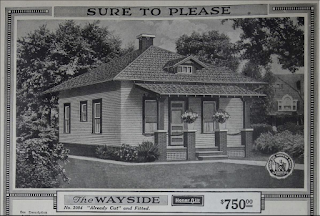 |
Sears Wayside in the 1918 catalog
(click to enlarge) |
Here's a new addition to our National Database of Sears Houses in the United States: An authenticated Sears Wayside.
As you can see, it's a very simple style, that every lumber company and kit company offered a version of, I'd say. But... at the time that I found it, a few days ago, it was the first Wayside to be added to our list...and how do we know for certain that it's a Sears house, and from the era of the Wayside? Because I found it through mortgage research in St. Clair County, Illinois. The house was bought in 1918 by Yugoslavian Anton Jureziz, who was about 45 years old, and had emigrated to the U.S. from his then-home in Germany, eight years before. I'll tell his story in a bit, but let me give you, first, the background on this model, the Sears Wayside... and why this isn't, actually, the first Wayside on our list.
Alberta vs Wayside & Wayside vs Rest
The presentation of this house in our research group, really began with my mention that two models -- the
Alberta and the
Wayside -- are almost the same: they just have different porch supports.
But, then, we remembered that the
Wayside later became the
Rest.
Although... actually... it all started with the
No. 400... that became the
No. 216.
And, the
Alberta and the
Wayside originally were known with numbers:
No. 107 &
No. 107B
Here's the scoop:
The
No. 400 /
No. 216, the
Alberta, and the
Wayside, are essentially the same house, with different porch treatments (okay, and one window fewer on the No. 400 / 216.) Then, they were all done away with, and the
Rest became the new version of the
Wayside.
The
No. 400 was the first one offered-- I see it in the 1912 catalog. It was re-named the
No. 216 in the 1913 catalog. The
Alberta and the
Wayside were offered simultaneously, from 1916 through 1918. Beginning in 1920, the model was very slightly changed, and was marketed as the
Rest.
The
Alberta and
Wayside are the same house, offered the same years, but with the difference being the support structure for the little porch roof: the
Alberta uses just big, 5-piece brackets, but the
Wayside has nice, heavy masonry bases, topped with wood porch pillars. The
Alberta/Wayside porch also does not span the whole width of the front of the house, and has a flat roof jutting out from just under the main roof of the house.
The No. 400 / 216, however (their predecessor), has a different porch altogether: it spans the width of the house, it has a shallow hipped-roof over the porch, and the porch is supported with all-wood railings and full-height wooden pillars. Other than that, the three models are pretty much the same... the footprint and floor plans are exactly the same (and have no bathroom!). There is also one window not shown on the left side front of the No. 216, too. Let's take a look:
 |
Notice that none of the models has a bathroom! Outhouse times!
(Click to enlarge.) |
But... wait! In 1916, Sears also offered the
No. 216-A... evolved from the
No. 216 with the removal of the dormer, and the addition of a bathroom! It also got a little window for the living room, which it expanded the length of, to call part of it the dining room, took away the pantry for the kitchen, and part of the kitchen space:
 |
| The No. 216 evolves with important changes in the No. 216-A floorplan... this floorplan later is marketed as the Kismet. |
In terms of porch, it combines the roof of the
No. 400 / 216, with masonry-based porch supports more like the later
Wayside:
 |
| 1913 catalog • The No. 216. |
 |
| 1916 Catalog • I hate to say this, but though there are four porch columns here, in other catalogs in 1916, the same model has only the two outer wooden columns... just like the Wayside. Then, even later in 1916, the porch roof changes, too... and then, it becomes the Kismet, in 1918. |
 |
|
(click to enlarge)
|
The whole concept of the No. 216-A is eventually turned into the Kismet (in 1918)... with the porch roof changed to jut out from the front section of the main roof, instead of from under it:
 |
1918 catalog • Remember, the Kismet has no dormer.
To see the interior of a Kismet found by researcher Andrew Mutch, go here. |
But, we're not here to talk about the Kismet (though it is awfully similar on the outside) !
I really just wanted to focus on the Alberta, Wayside, and Rest. Let's have a list:
1912 Catalog
No. 400: Has dormer, same size and floor plan as the later Alberta (No. 107) and Wayside (No. 107B)-- but, different porch from Alberta and Wayside.
1913-1914 Catalogs
No. 216: Exactly the same as the No. 400, just new number.
1916-1919 Catalogs
(No. 216-A: Same size, but new floor plan, new porch, and no dormer... evolves into the Kismet )
Alberta (first marketed as No. 107 * ): Has dormer, same size and floor plan as the Wayside, but porch supports are just big brackets.
Wayside (first marketed as No. 107B ): Has dormer, same size and floor plan as Alberta, but porch supports are masonry base with wood pillars.
1920-1925 Catalogs
Rest: New name of the Wayside -- same floor plan, though with the addition of a back porch, and an extra window on the left side. Alberta is gone.
* Note that there is a No. 107 model in the 1913 catalog that is a completely different house--not even a bungalow.
Let's take a look just at the evolution from the 216, to the Alberta and Wayside, and then the Rest :
 |
| Earlier called the No. 400 -- same house, though (By the way, the No. 400 is not in Houses By Mail ) |
 |
Nearing the end: The Rest in the 1923 catalog (it ran from 1920-1925).
Go here to see a Sears Rest in Cincinnati, Ohio, found by research Cindy Catanzaro |
A comparison of the
Wayside and
Rest floor plans shows very little difference, but there is some change. The
Rest has an additional kitchen window, and, off the back of the kitchen, a big closet was added, as well as an enclosed porch that has space for the ice box, and a staircase to the cellar (you can see that enclosed back porch sticking off of the back of the
Rest, in the 1923 catalog image, above). Here are the floor plans, side by side:
 |
| The Wayside vs the Rest |
So, how do we know that the house that Anton Jureziz built, is a
Wayside? Because the mortgage was from 1918... just as the
Wayside was about to be phased out, and re-marketed as the
Rest. Now, on the house as it stands today, it has lost the pantry window on the left side (sided over), so you only see two windows on that side. You do see a back porch-- but, that has been added on in later years, and spans pretty much the whole back of the house (see how the grey masonry foundation of the original house ends, before you get to the back porch?):
 |
| Authenticated Sears Wayside • 20 E. George Street, Mascoutah, IL |
 |
| Authenticated Sears Wayside • 20 E. George Street, Mascoutah, IL |
 |
| Authenticated Sears Wayside • 20 E. George Street, Mascoutah, IL |
 |
| Here is the current footprint of the Jureziz house, showing a wide back porch. |
Why This May Not Be Our First Wayside On The List
So, when I found this house a few days ago, we had no
Wayside examples on our national database (and, remember, our database is a list of what has been FOUND... not a list of what houses were sold by Sears... there is no existing list of those records). But, we had two examples of the
Rest. Searching in our group, I found, though, that one of those -- a house in Stockport, Ohio -- was thought to be the house referred to in the catalog, on pages showing the
Rest. We call those "Built At" houses, because the catalog pages sometimes list places where that model has been built... and says, "Built at...". Well, the thing is... we see that "Built at... Stockport, Ohio" mention in the 1918 catalog! When the model was still called the
Wayside! So... that means that the house in Stockport was not a
Rest, technically, it was a
Wayside. Or, actually... probably a
No. 107B, because it was built before 1918. Here's that mention, on the catalog page:
 |
This is down in the lower corner, of the 1918 catalog
page for the Wayside. |
 |
| From the 1918 catalog. |
 |
| Close up... down there in the corner, of the 1918 page of the Wayside. |
What added to our confusion, is that the same "Built at..." blurb is ALSO on the page in 1921, for the
Rest. Sears did that... if they had a testimonial or a "Built at..." comment to show, but the model had had a name change, they didn't clarify that... they just continued to include the information on catalog pages for the new model name. I found that to be the case for
a testimonial Langston that I blogged about a few years ago. Here, for example, is the 1921 catalog page for the
Rest, showing the same "Built at..." blurb at the bottom right:
And, here is the house in Stockport, Ohio. The photo is a little grainy, and, darn it, there is a darn porch in the back... but, it must have been added on. And, the house has also been enlarged on the side. Researcher Nigel Tate is the one who informed us of the whereabouts of this Stockport, Ohio house (but, he learned of it from someone else--please feel free to leave a comment, if you happen to know who that was). We don't know for certain that it's our "Built at..." house, but it's pretty likely. Those front porch columns, that front porch style, and the little dormer (and the left side windows), are a pretty good indication.
 |
| 3260 Washington Street, Stockport, Ohio • probable Sears No. 107B (Wayside) |
In any case, it's not that we were thinking that this authenticated
Wayside of Anton Jureziz was the first
Wayside ever sold (ha!), we just hadn't located any, and added them to the list. But, this was probably a very popular model for the modest budget, and, indeed, in Rebecca L. Hunter's book,
Putting Sears Homes On The Map (which lists all of the town locations for "Built at..." and testimonial Sears homes), there are 22 listed, spread across a number of states. They are -- or were-- out there. But, little homes like this tend to be torn down, or greatly added on to, or, if we run across one, we're just not sure that it's a Sears example... porches get changed, porch roof supports get changed... or, we're not sure if it's a
Rest or a
Wayside. And, in this, our little ... I mean our HUGE ...
"Historical Treasure Hunt", we get excited about adding a new house to the list.
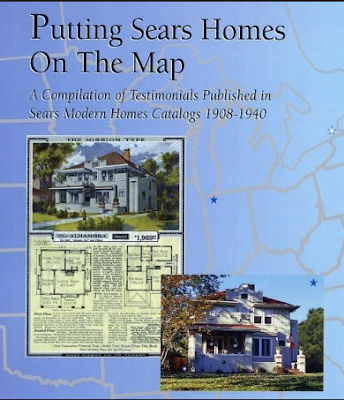 |
| You can buy Rebecca L. Hunter's book, here. |
Who Was Anton Jureziz?
Anton Jureziz was a man who was born in Yugoslavia, I believe (though 1930 census says Austria-- I think that's an error, because the 1920 census says Yugoslavia, and both years list Slovenia [sic] as the family's language. Also, Anton, Jr.'s naturalization paperwork says that he is renouncing his allegiance to the "kingdom of Serbs, Croats, and Slavenes"... which would be Yugoslavia) and who emigrated to the United States in 1910... or possibly 1908. I actually learned much of what I know about his immigration, through information I found about his son, Anton "Tony" Jureziz, Jr. From the 1930 census, we know that Anton (Sr.) was a widower, and lived in the house on George Street with his 23 year old son, Tony. But, next door, lived Albert Jureziz, aged 27 (and his wife, Helen, and their two children). Considering his age, we can assume that Albert is no doubt Anton Sr.'s son.
 |
| 1930 U. S. Census for Mascoutah, Illinois |
 |
| Confusion in the census records... I guess it happens when the people being interviewed don't speak English well. This is from the 1930 US Census for Anton Sr. and Tony, Jr. |
 |
| This, however, is the 1920 US Census for them, clearly showing the same family, but it lists Yugoslavia as place of birth. It also gives 1908 as year of immigration... either that is wrong, or Anton Sr. came a couple of years earlier than Anton Jr. |
Naturalization records for Anton Jureziz, Jr. (son "Tony") say that he arrived in the U.S. in July of 1910, and that he was born in
Stoppenberg, Germany, in 1907... so, Anton Sr. must have brought him here to the States, in 1910... along with, we assume, the rest of the family. Was he already a widower? I wasn't able to find that out... I only know that he is listed thusly in the 1930 census.
 |
| Naturalization application papers for Anton Jureziz's son, Anton Jureziz, Jr. |
Another naturalization paperwork, for the state of Illinois,
Anton Jr.'s petition for citizenship papers list
Frillendorf, Germany, as his last residence before coming to the U.S. It looks (on Google maps) like Frillendorf is right next to Stoppenberg, where he was born. Both are part of Essen, Germany (I don't really know how Germany is split up, but Essen is a big city, and Frillendorf and Stoppenberg both have the word "Essen" after them, on the map).
Anton Jureziz came to the United States on the SS Kroonland, which is a ship from the Red Star Line, that sailed from Antwerp, Belgium (here's a
modern-day image of the Port of Antwerp--very nice). I've got a few photos of the ship, and then some stills taken from
this great 3-minute little video someone put together about the ocean liner.
As Anton Jureziz was a coal miner (at least in Mascoutah, Illinois, he was), I assume that the family rode in steerage, so they may not have enjoyed the interior spaces shown in the photos above.
Anton Jureziz, Jr., and His Wife, Ethel
Though Anton Jureziz, Sr., bought (and built?) the Sears Wayside on E. George Street, his son Anton, Jr.. grew up there, so I enjoyed learning a bit about him, too. He was a teacher of woodworking, and coached several sports -- track and baseball, and maybe basketball as well. He coached at Alton High School (in Alton, Illinois, about an hour north of Mascoutah). During WWII, his wife, Ethel, lived in St. Louis, while Anton was away. One item I read in a newspaper article, said that Anton had served in some capacity in the armed forces as a director of athletics, or something like that. Who knew that was a thing? In any case, after the war, he returned to his teaching and coaching jobs, but later moved from Alton to Franklin Park, Illinois, up near Chicago, to continue coaching and teaching in a new setting.
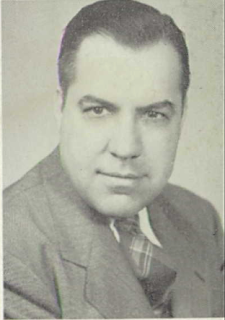 |
| Anton Jureziz, Jr., in the 1951 yearbook for Alton High School |
I was very interested to see that his wife, Ethel, had been an art instructor. In 1940, the Alton town newspaper wrote a bit about a presentation that Mrs. Anton Jureziz Jr. did, for the group "University Women". The topic was, "American Crafts--the Old and the New", in which she spoke of native American art.
 |
| From a 1940 article in an Alton, Illinois newspaper |
They would have never lived in the Sears Wayside in Mascoutah, Illinois, but Anton Jureziz Sr. lived there until 1951, when he passed away. He is buried in a cemetary in Mascoutah.









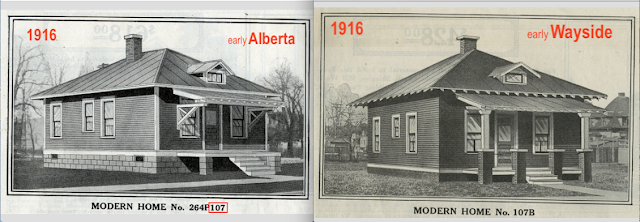

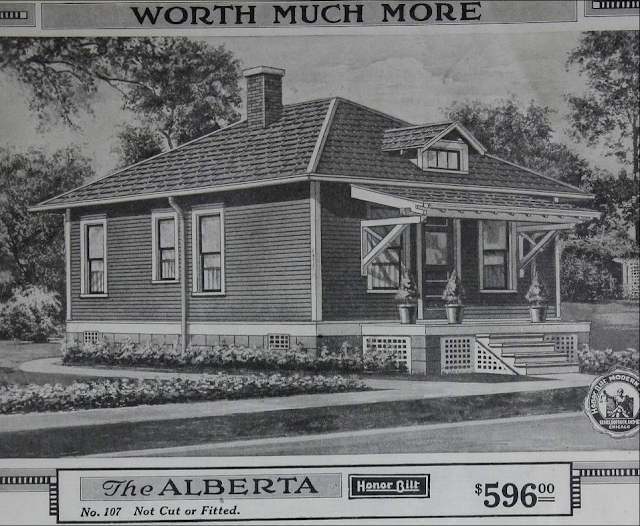


















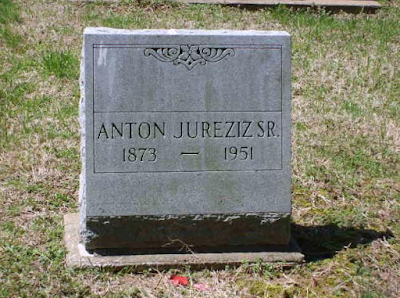


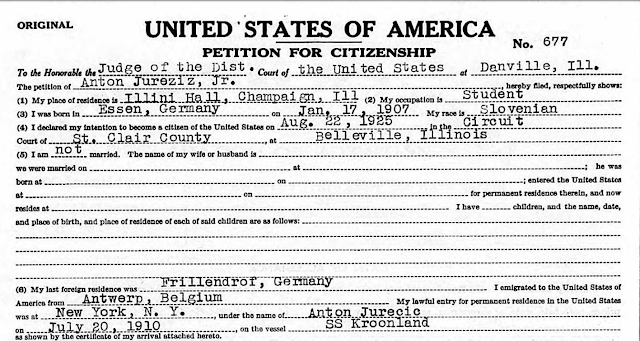



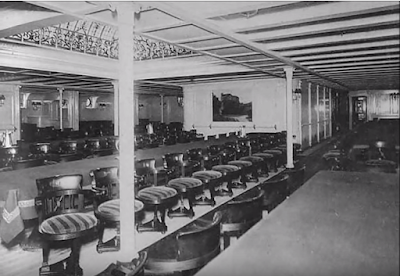
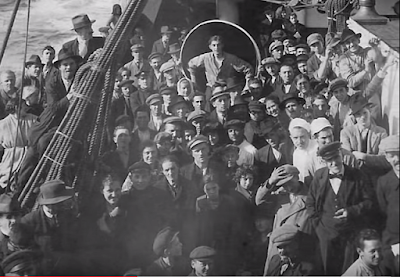



The house in Ohio, whatever it might be.....was originally located by somebody in that big ole' Facebook group about Sears Homes. I think it was Mark something or other. It's been such a long time ago, I don't remember his last name. The folks in there forget who helped them identify models sometimes, too.......Guess we're getting old. ;)
ReplyDeleteI wish I could identify my Sears home. Small Cottage in a fishing town. 4 rooms, center chimney.
ReplyDelete